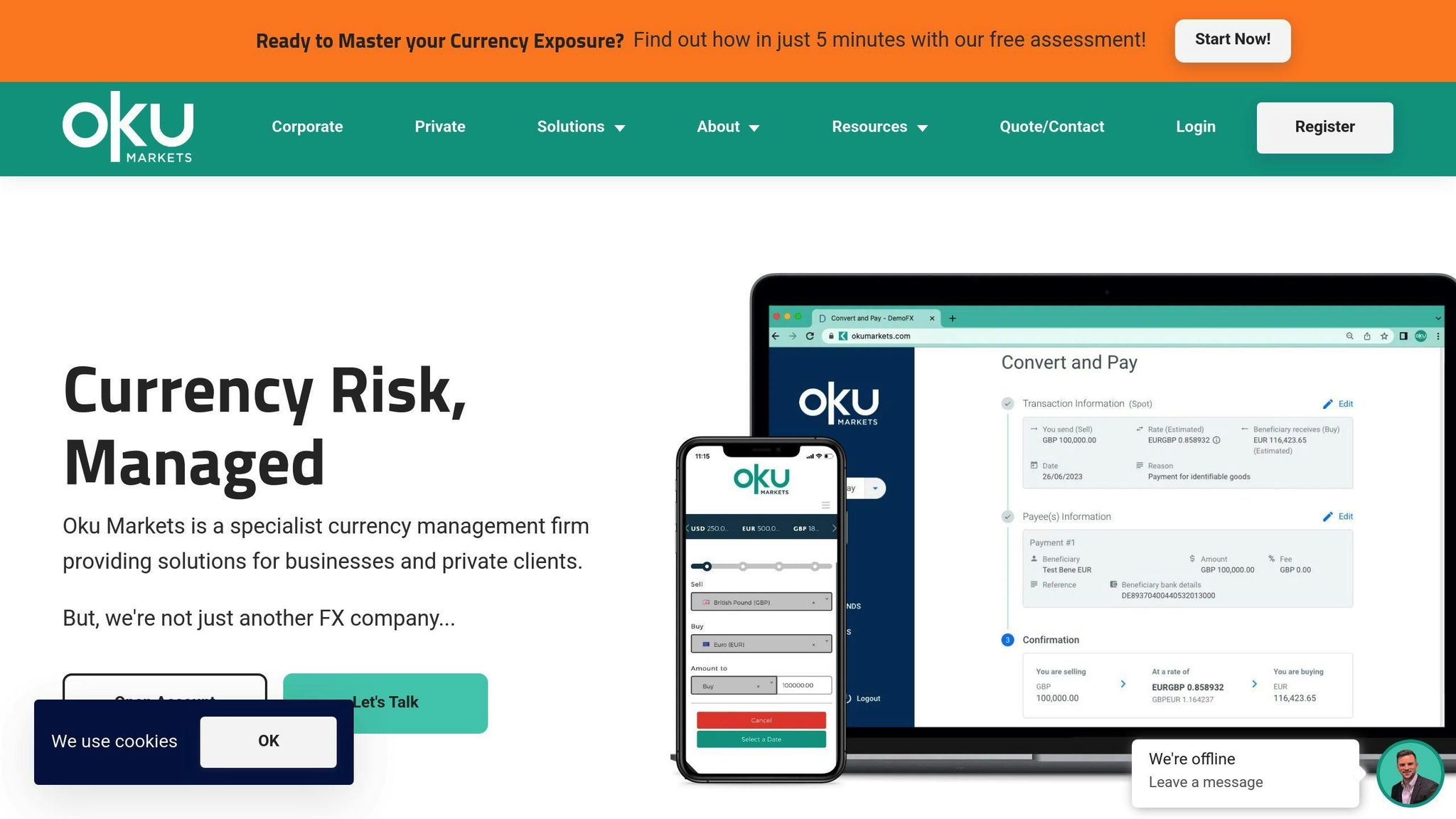Startups operating internationally face a big challenge: currency fluctuations can hurt profits, cash flow, and financial stability. Managing FX (foreign exchange) risk is crucial to protect your business from these unpredictable shifts. Here's how to get started:
- Identify FX Risks: Audit revenue, costs, and financial obligations tied to foreign currencies.
- Use Simple Strategies: Match revenues and expenses in the same currency, open local bank accounts, or add currency clauses in contracts.
- Leverage Financial Tools: Forward contracts and options can lock in exchange rates, offering predictability.
- Monitor and Adjust: Track live exchange rates, review your FX policy, and use digital tools for real-time updates.
Startups often lack resources to manage FX risks effectively, but tools like HedgeFlows and Oku Markets simplify the process. Take control of your currency exposure today to safeguard your business.
Evaluating Your FX Exposure
Before diving into strategies, it’s crucial for startups to pinpoint where they face FX risk. This means taking a close look at how currency fluctuations might impact your business operations and finances.
Steps for a Currency Audit
Conducting a currency audit can uncover areas where your startup is vulnerable to FX risk. Focus on these key areas:
| Area to Audit | What to Look For |
|---|---|
| Revenue Streams | Payments from international clients, income in foreign currencies |
| Costs and Suppliers | Payments to overseas suppliers or contractors, hidden currency risks in pricing |
| Financial Obligations | Foreign currency loans, international investments |
As Antonio Rami, Founder & Chief Growth Officer of Kantox, wisely puts it:
"Don't look at the market, look at your business."
Assessing the Impact of Currency Fluctuations
To get a handle on FX risk, use tools like HedgeFlows to track currency risks in real-time. These platforms can also help you create cash flow forecasts in various currencies, highlighting timing mismatches or seasonal trends.
Sensitivity Testing: Analyze how shifts in exchange rates could affect your profits. Pay attention to:
- The timing of payments and receipts in foreign currencies
- Seasonal trends in your currency needs
- Cash flow gaps caused by exchange rate changes
Once you’ve mapped out your FX exposure, you’ll be ready to implement strategies to manage these risks effectively.
FX Risk Management Strategies for Startups
Once you've identified your FX exposure, the next step is to apply strategies that can help minimize potential risks.
Natural Hedging Methods
Natural hedging focuses on balancing currency inflows and outflows without relying on complex financial tools. It's a practical starting point for startups working with limited budgets.
| Strategy | How It Works | Key Advantage |
|---|---|---|
| Revenue-Expense Matching | Align product pricing with supplier payment currency | Cuts down on currency conversion needs |
| Local Banking Setup | Open and use accounts in the same currency as transactions | Reduces conversion fees and timing risks |
| Contract Structuring | Add currency adjustment clauses in agreements | Shares FX risk with business partners |
Using Forward Contracts and Options
When natural hedging isn’t enough, financial instruments can step in to provide additional security. Forward contracts, for example, allow businesses to lock in an exchange rate for future transactions, offering predictability but requiring a firm commitment to a specific rate.
Here are some common tools to consider:
- Forward Contracts: Secure exchange rates in advance for upcoming transactions.
- Options: Offer flexibility to secure favorable rates, although they require an upfront premium.
- Simple Swaps: Exchange currency flows at agreed-upon rates to manage exposure.
"If you want to gamble, currency is not the best place. It's much easier and cheaper to gamble in a casino".
Timing and Diversifying Transactions
While financial tools provide structure, timing and diversification offer more adaptable ways to handle FX risks. Startups can use free or low-cost monitoring tools to:
- Track live exchange rates.
- Study currency trends to make informed decisions.
- Pinpoint the best times for transactions.
- Maintain reserves in frequently used currencies to avoid last-minute conversions.
This combination of strategies allows startups to stay flexible while reducing exposure to short-term currency fluctuations.
sbb-itb-6b3a4a4
Creating an FX Risk Management Framework
A well-structured approach to managing FX risk helps startups stay in control of currency exposure while aligning with their business goals. This method ensures consistent decisions and clear accountability throughout the organization.
Establishing an FX Policy
An FX policy acts as the backbone of your currency risk management efforts. It should clearly define how your startup handles currency risks, tailored to your specific needs and capabilities, while keeping implementation straightforward.
| Policy Component | Key Elements | Purpose |
|---|---|---|
| Risk Tolerance | Maximum acceptable exposure | Sets clear boundaries for currency risk |
| Hedging Guidelines | Minimum hedge ratios, timeframes | Provides rules for protection |
| Decision Authority | Roles and approval limits | Assigns accountability |
| Review Schedule | Frequency of updates | Keeps the policy relevant |
For example, your policy might specify: "Hedge 60-100% of forecast imports within six months; board approval required for longer terms." This ensures accountability while offering flexibility to accommodate startup operations.
Once the policy is established, consistent tracking and reporting are crucial to measure its success and adjust to market changes as needed.
Tracking and Reporting FX Risk
Regular monitoring ensures your FX strategy stays aligned with both market conditions and business objectives. Key areas to focus on include:
- Track live exchange rates and analyze their impact on profit margins.
- Measure hedging performance against the goals outlined in your policy.
Reporting Framework
- Keep detailed records of currency positions and hedging activities.
- Share regular updates with stakeholders to maintain transparency.
Even major corporations have suffered significant losses due to poor FX risk management. This highlights the importance of a strong monitoring system for businesses of any size. Regularly review and update your FX framework, especially when market conditions or your operations evolve.
Using Tools and Resources for FX Risk Management
Startups often face challenges in managing FX risk due to limited resources. Thankfully, modern tools and platforms can make the process more efficient and manageable.
Oku Markets

Oku Markets specializes in currency management solutions designed specifically for startups. They focus on transparent pricing and personalized service. Here's what they offer:
| Service | Purpose | How It Helps Startups |
|---|---|---|
| Currency Audits | Identifies your FX risk profile | Provides a clear map of potential risks |
| Forward Contracts | Tailored hedging solutions | Helps secure protection strategies |
| Collection Accounts | Simplifies international payments | Cuts down transaction costs |
| Expert Analysis | Offers market insights | Guides informed hedging decisions |
Online Currency Platforms and Tools
Digital platforms simplify international transactions for startups. Tools like TransferWise and WorldFirst provide features such as real-time exchange rate monitoring, automated transactions, and reduced fees. These platforms can also integrate easily with your accounting systems, saving time and effort.
Negotiating with Financial Providers
Building strong relationships with financial providers can lead to better terms and pricing. Here are a few strategies to consider:
- Be Prepared with Documentation: Keep detailed records of your FX volume, future currency needs, and risk profile. This demonstrates professionalism and understanding.
- Compare Rates: Work with multiple providers to compare rates and secure competitive pricing. Users of platforms like HedgeFlows and CorpHedge have reported saving 20-30% on transaction costs by encouraging provider competition.
- Set Service Expectations: Establish clear service level agreements (SLAs) to outline trade execution standards and performance reviews.
"Clear goals and timely data are what separate FX hedging from gambling." - HedgeFlows
Conclusion: Ensuring Financial Stability with FX Risk Management
Key Points and Next Steps
Large enterprises often prioritize hedging against FX risks, but startups frequently overlook this, leaving themselves open to potential financial instability. For startups with unpredictable cash flows and fewer resources, managing FX risk is essential for maintaining stability over time.
Managing FX risk effectively involves assessing potential vulnerabilities, applying strategic solutions, and using digital tools for ongoing tracking. To safeguard your business from currency fluctuations:
- Evaluate your currency exposure through a detailed assessment.
- Implement simple hedging techniques suited to your business model.
- Use digital tools to monitor exchange rates in real time.
Consider starting with practical steps like revising pricing models or using forward contracts. Adding currency buffers and regularly forecasting cash flows can also help maintain financial stability.

